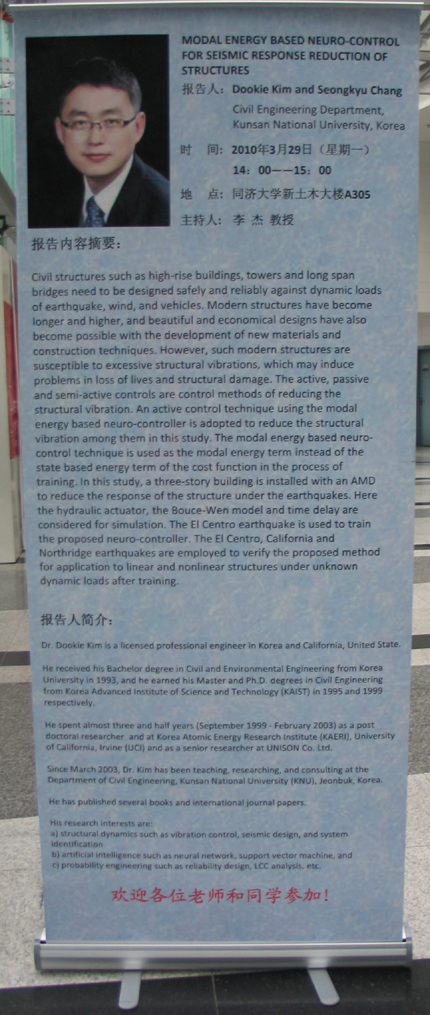 报告人:Dookie Kim and Seongkyu Chang
报告人:Dookie Kim and Seongkyu Chang
Civil Engineering Department, Kunsan National University, Korea
报告人简介:Dr. Dookie Kim is a licensed professional engineer in Korea and California, United State.
He received his Bachelor degree in Civil and Environmental Engineering from Korea University in 1993, and he earned his Master and Ph. D. degrees in Civil Engineering from Korea Advanced Institute of Science and Technology (KAIST) in 1995 and 1999 respectively.
He spent almost three and half years (September 1999- February 2003) as a post doctoral researcher and at Korea Atomic Energy Research Institute (KAERI), University of California, Irvine (UCI) and as a senior research at UNISON Co. Ltd.
Since March 2003, Dr. Kim has been teaching, researching, and consulting at the Department of Civil Engineering, Kunsan National University(KNU), Jeonbuk, Korea.
He has published several books and international journal papers.
His research interests are:
(a) structural dynamics such as vibration control, seismic design, and system identification
(b) artificial intelligence such as neural network, support vector machine, and
(c) probability engineering such as reliability design, LCC analysis, etc
ABSTRACT:Civil structures such as high-rise buildings, towers and long span bridges need to be designed safely and reliably against dynamic loads of earthquake, wind and vehicles. Modern structures have become longer and higher, and beautiful and economical designs have also become possible with the development of new materials and construction techniques. However, such modern structures are susceptible to excessive structural vibrations, which may induce problems in loss of lives and structural damage. The active, passive and semi-active controls are control methods of reducing the structural vibration. An active control technique using the modal energy based neuro-controller is adopted to reduce the structural vibration among them in this study. The modal energy based neuro-control technique is used as the modal energy term instead of the state based energy term of the cost function in the process of training. In this study, a three-story building is installed with an AMD to reduce the response of the structure under the earthquakes. Here the hydraulic actuator, the Bouce-Wen model and time delay are considered for simulation. The EI Centro earthquake is used to train the proposed neuro-controller. The EI Centro, California and Northridge earthquakes are employed to verify the proposed method for application to linear and nonlinear struvtures under unknown dynamic loads after training.
报告时间:2010年3月29日(周一)14:00
报告地点:土木大楼A305室
主 持 人:李 杰教授
热 忱 欢 迎 广 大 师 生 参 加!!!
